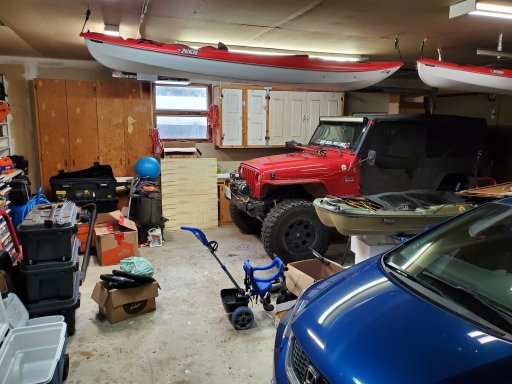
Advocate I

Advocate I

Influencer III
19540

Advocate I
I'll have to look at the modle number and see what I can find. It was free so if I can made it work it would be awesome lolI bought one those cheap, but it turned out there are two versions. One for smart alternators and the other for old school alternators. Their website is pretty helpful figuring out how to use it.

Member III

Advocate I

Advocate I

Member III
If you give the center pin power both the others should show battery voltage (as this is simulating the alternator). If you give power to the left or right, the others should read zero.So weird thing. Just ran a bench test on the spare battery to the center pin of the isolator and it came out with even voltage on both sides. I suppose next step is to run a ju.per off the alternator and see what happens lol .... that's not a tonight challenge....

Advocate I
When I was reading through about this model it was talking about working for alternators with no internal voltage regulator, which I kinda figured meant that it was converting from AC power to DC power itself. Which made me think that if I out power to center I would only have power to one side at a time. But I really don't know anything about this kinda stuff I'm kinda leaning on the fly.If you give the center pin power both the others should show battery voltage (as this is simulating the alternator). If you give power to the left or right, the others should read zero.

Member III
So the alternator generates an AC current but it has rectifier circuitry to convert that to DC before the output terminal. The voltage regulator is strictly to maintain a usable voltage in the 12.5v to about 14.5v range. Dumb alternators are more RPM dependent with a slightly lower idle voltage than at cruise but a modern smart alternator will vary greatly. If you have a vehicle with a smart alternator, this isn't a great device to be using because the vehicle will be trying to adjust voltage for economy and won't see the changes. Someone mentioned there is a smart alternator version but I have no idea how that would interact with some vehicle systems. This is an older tech which works great on simple systems but likely won't interact so well with modern vehicles.When I was reading through about this model it was talking about working for alternators with no internal voltage regulator, which I kinda figured meant that it was converting from AC power to DC power itself. Which made me think that if I out power to center I would only have power to one side at a time. But I really don't know anything about this kinda stuff I'm kinda leaning on the fly.
I believe the original manufacturer for this one was bought out by littlefuse and is being remanfactured by them now. It was hard to find info on it and some of the information didn't really line up 100% so I was guessing a little.

Advocate I
To be honest I don't really do anything that would require a second battery other than to have a backup in case mine goes dead. I don't usually run a whole lot of electronics but have toyed with the idea of a fridge in the future.So the alternator generates an AC current but it has rectifier circuitry to convert that to DC before the output terminal. The voltage regulator is strictly to maintain a usable voltage in the 12.5v to about 14.5v range. Dumb alternators are more RPM dependent with a slightly lower idle voltage than at cruise but a modern smart alternator will vary greatly. If you have a vehicle with a smart alternator, this isn't a great device to be using because the vehicle will be trying to adjust voltage for economy and won't see the changes. Someone mentioned there is a smart alternator version but I have no idea how that would interact with some vehicle systems. This is an older tech which works great on simple systems but likely won't interact so well with modern vehicles.
This device likely has a regulating circuit that caps voltage at a flat 14.x or something to prevent over-volting and blowing up a battery. It's unlikely do be dynamic so I'm not sure how well it would work on a newer system and would suggest a Blue Sea ACR or Redarc for that route.

Advocate I

Member III

Advocate I
So I basically would use a secondary battery to charge random equipment around camp like a radio or a phone. All of my main power comes off the primary battery on the jeep. Do you think it would s be a viable option since it's basically free just to have a little extra power around?@LostWoods hit the way an alternator works pretty well. Let me chime in on the regulator part.
A little "alternator 101" first (without getting too involved)
The rotor (center) is a magnet. It spins inside a series of coils (stator).
The output from the stator is controlled by turning the rotor on and off.
The regulator controls the rotor.
That's the basic.
The difference in regulator design is pretty simple. Old school regulators will sample voltage from "somewhere" and are built to bring that voltage up to what their set to. If its set to 14.2 volts and sampling from the fuse block, it will raise output voltage until it sees 14.2 at the sample.
The "smart" alternators are in two categories.
1. Old school sampling but the regulator is in the PCM (Jeep TJ)
2. More like a smart charger to properly maintain. These are not common and are tuned for lead acid batteries.
Isolators can also be diffrent types as you now know. The better ones will monitor diffrent batteries and control the voltage and amperage properly (battery management systems). The lesser ones are just power transistors separating the two batteries (isolators). That is what you seem to have.
The issue with the isolator types is they create a small volt drop and depending on where your alternator is sampling from can change the charging voltage. This may or may not be an issue.
I personally don't use transistor isolators, I use a high currant relay to isolate my batteries. Almost no volt drop and good charge rate. I wont bother with a management system because I run AGM's, their not that picky and my alternator runs at 14.4v at the batteries. Lithium's are another story.

Member III

Advocate I
Lol ya I know. I've been working on the TJ for almost a decade ( and I've had many before it). I'm waiting on some steering parts to come in so I was looking around my garage while doing some organizing and thinking about what I could do with stuff I have lying around lol.I run dual batteries because of my "extra" stuff. The second battery is also tied straight to my winch. I can jump across if I need but my solenoid will flow 300 amps (more than enough to start my vehicle). If ya got it already, the worst thing will be you take it off later. soon your garage looks like mine.
remember, this is how it all starts.
1. buy 4wd.
2. add small free mods
3. go off road
4. more mods
5. go more places
6. mortgage house and sell kidney to support your habit.




Member III

Advocate I
